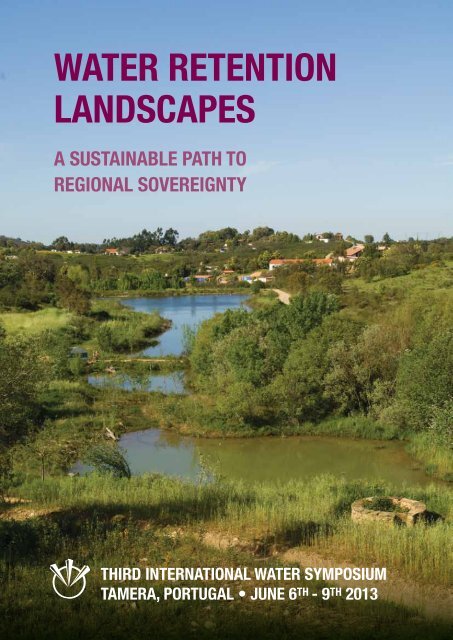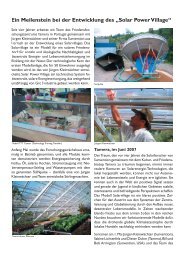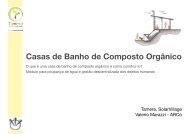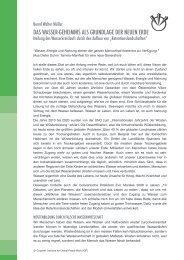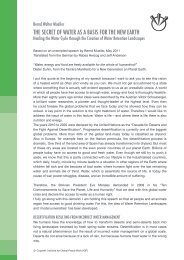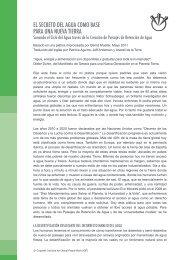Water Retention Landscapes - A Sustainable Path to ... - Tamera
Water Retention Landscapes - A Sustainable Path to ... - Tamera
Water Retention Landscapes - A Sustainable Path to ... - Tamera
- No tags were found...
You also want an ePaper? Increase the reach of your titles
YUMPU automatically turns print PDFs into web optimized ePapers that Google loves.
modera<strong>to</strong>rsContribu<strong>to</strong>rs„ Behind the global massacre of our times stand wrong systems of economy, wrong concepts of love andreligion, wrong systems of thought, and the endless abuse of natural resources. The new planetary communityis making a fundamental system-change from the matrix of fear <strong>to</strong> the matrix of trust. It is doing soin all areas – from personal relationship issues <strong>to</strong> the political and ecological issues of the healing of theplanet. This system-change is a change of power. The new power no longer consists of domination overothers but of reunification with the sacred laws of life. “Dieter Duhm, The <strong>Tamera</strong> Manifes<strong>to</strong>JULIETTE BAIGLER • United KingdomJuliette was born in 1974 in London. She has a lifelong fascination for theexperience of being human and for exploring how we can heal and flourish<strong>to</strong>gether. Juliette’s professional practice as a coach, facilita<strong>to</strong>r and learningconsultant, using community-building methodologies, began in 1999when she worked with young people in areas of urban deprivation. In 2001she became a founder-member of Mango Communities CIC; a consultancywhich offers participa<strong>to</strong>ry capacity-building interventions <strong>to</strong> NGOs, businessesand multi-agency partnerships, in the UK and internationally. Juliettealso work as a coach <strong>to</strong> leaders in schools, NGOs and businesses and is apresiding chief of the council at Embercombe, a social enterprise which inspires people <strong>to</strong> committedaction <strong>to</strong>wards the emergence of a socially just, environmentally sustainable and spiritually fulfilling humanpresence on earth. She holds an undergraduate degree in Religion with Literature and a Masters inChange Agent Skills and Strategies. She is an accredited leadership coach, a qi gong practitioner and apainter.Benjamin von Mendelssohn • Germany/PortugalBorn 1973, a successor of the Jewish Berlin artists and bankers family “vonMendelssohn”, in whose humane tradition he is standing. At the age of 19 heworked in the Peace University in Potsdam, Germany. Engaged in many peacegroups he came <strong>to</strong> the conclusion that political work, in order <strong>to</strong> be really successful,must be connected <strong>to</strong> the development of non-violent alternatives. Forsome years he has been doing reconciliation work between Jews and Germansas well as between Jews and Palestinians. He visited the Middle East manytimes, directed peace camps and pilgrimages and is weaving a worldwide networkof peace workers with the goal <strong>to</strong> found international Peace ResearchVillages. He is the direc<strong>to</strong>r of the “Peace Research Village Association”, Germany, and a graduate of thepeace training in <strong>Tamera</strong>.Joss Brooks • IndiaJoss Brooks grew up in Tasmania, a place full of wild natural beauty and wideopen empty spaces. After living in Europe and Africa he came <strong>to</strong> Auroville nearPondicherry in 1970 <strong>to</strong> participate in its early pioneering work. In 1973 heestablished Pitchandikulam dedicated <strong>to</strong> res<strong>to</strong>ring the eroded 60 acres ofAuroville Green Belt land <strong>to</strong> its former green cover. Now it is a vibrant forestwith more than 600 species of plants, many with medicinal value and a nurserythat grows the endangered species of the almost extinct Tropical Dry EvergreenForest found along the Coromandel Coast. In 1993, associating with theFoundation for Revitalization of Local Health Traditions (FRLHT), he developedthe medicinal plant conservation Park at Pitchandikulam which served as a base for work with the villagecommunities and traditional healers living around the Kaluveli wetland, north of Auroville. In 2002, theNadukuppam Environment Education Center was founded at a Government High School near the wetlandfrom where a team of environmental education teachers from the local villages began <strong>to</strong> work with schoolchildren, women’s groups and farmers <strong>to</strong> implement eco-res<strong>to</strong>ration initiatives. In 2004, PitchandikulamForest Consultants was created <strong>to</strong> implement res<strong>to</strong>ration work in other areas of Tamil Nadu including thecity of Chennai. A 12 acre garbage dump at Otteri in North Chennai has been transformed in<strong>to</strong> a greenlung of indigenous vegetation. In 2005, the Pitchandikulam team began work on a master plan for a 350acre controversial wetland site at the Adyar estuary. Over the following years, the typical urban wastelandenvironment of debris, garbage and sewage has changed in<strong>to</strong> an example of species regeneration, practicalenvironmental education and citizen/ government collaboration. The Adyar Poonga wetland res<strong>to</strong>rationproject is still very much underway, yet evolving in<strong>to</strong> a crucial larger initiative <strong>to</strong> cleanse and transform theother polluted waterways of Chennai.Through all the hard work, he was guided by the "Mother" Mira Alfassa. “She <strong>to</strong>ld us that the spirit of theforest and wilderness were there <strong>to</strong> help if we could connect with it. Mother encouraged us <strong>to</strong> imagine thepossibility of what could be.”Patrick de Buck • Belgium/The gambiaProject coordina<strong>to</strong>r in a dambuilding project in Burkina Faso, developer of anetwork for food security in Burkina Faso, Senegal, Mali, Gambia and GuinéeBissau. From 2002 - 2008 he was setting up a network for direct trade (farmerconsumer)in the Province of East and West Flanders (Belgium) in order <strong>to</strong>s<strong>to</strong>p the destructing influence from industrial processed food on the survival offarmers in Belgium. From 2009 - 2012 he retired and volunteered for organizationalstrengthening of two Gambian organizations. He is <strong>to</strong>day involved in athinktank with Gambian colleagues <strong>to</strong> work out a new concept for developmentaid intervention with the aim <strong>to</strong> fully erase poverty.8 9
Cooperation partnersPaulo Borges • PortugalPaulo Borges, Lisbon, is a professor, essayist, philosopher, poet and writer.He is co-founder and board member of the Institute of Philosophy Luso-Brazilian, corresponding member of the Brazilian Academy of Philosophy,founding member of Aperel - Association for the Study of Religions, and direc<strong>to</strong>rof the culture magazine BETWEEN Cultures, president of PortugueseBuddhist Union and the Association Agostinho da Silva and President of theParty for Animals and Nature (PAN).Alfredo Cunhal • PortugalAlfredo Cunhal runs the largest organic farm in Portugal: Herdade Freixo doMeio, close <strong>to</strong> Montemor-o-Novo in the Alentejo. Since 1990 he has developedthe farm of his family <strong>to</strong> a model for organic farming, rich diversity and natureprotection, reinforcing traditional techniques like Montado, the extensivegrowing of cork oaks and pigs. He is aware that in a region like the Alentejobeing a farmer means also <strong>to</strong> work on a proper water management.Jürgen Kleinwächter • GermanyTechnological cooperation partner of <strong>Tamera</strong>, physicist and inven<strong>to</strong>r, visionary.He developed the idea of the „Solar Power Village“, the technological core ofthe first model of a Solarvillage planned <strong>to</strong> be built in <strong>Tamera</strong>. He grew up inFrance, Germany and Egypt, studied physics and astrophysics in Grenoble andfounded with his father Hans Kleinwächter the KLERA-Institute: “KleinwächtersEntwicklung und Forschung, Raumfahrt und A<strong>to</strong>mtechnik” [Kleinwächter’sSpace and A<strong>to</strong>mic Energy Research and Development]. They investigated lightweigh<strong>to</strong>ptics, thermo-dynamics and concentra<strong>to</strong>r pho<strong>to</strong>-voltaic systems andtheir applications. Wishing <strong>to</strong> develop a peaceful technology which really helpspeople <strong>to</strong> improve their living conditions, he has dedicated himself <strong>to</strong> the research and application of solartechnology for 30 years. In cooperation with the Max-Planck-Institute and the IHK (Chamber of Commerceand Trade) of Stuttgart he has developed decentralised solar energy systems.André Vizinho • PortugalAndré Vizinho has been working for the creation of a sustainable village inAldeia das Amoreiras since 2006 with the group of which he his a memberand co-founder, Centro de Convergência. He is now working as an actionresearcherin bot<strong>to</strong>m-up adaptation strategies <strong>to</strong> climate change, namelyadaptation <strong>to</strong> drought in the Alentejo Region, in the project BASE. He is alsoa member of the Transition Network of Portugal and one of the trainers of theTransition Course. He is also a Permaculture designer and has been studying,implementing and teaching Permaculture design and solutions since 2005.Sepp Holzer • AustriaSepp Holzer, born in 1942 in Austria <strong>to</strong> a hill-farming family, is <strong>to</strong>day a visionaryfor landscape healing and permaculture farming and acknowledged worldwide.On his family farm, the Krameterhof – <strong>to</strong>day comprising forty-five hectares ofland, at an altitude of between 1100 <strong>to</strong> 1500 meters above sea level - he implementedthe knowledge that he had gained by observing nature, supportedby his wife Veronika.Today, the Krameterhof attracts thousands of visi<strong>to</strong>rs each year. Since SeppHolzer has passed his farm on <strong>to</strong> his son, he gives advice <strong>to</strong> landowners andprojects worldwide, in varied climate zones, and educates many people in permacultureaccording <strong>to</strong> his principles. Since 2007 he has advised <strong>Tamera</strong> in the construction of the waterlandscape.14 15
ReferencesAdaption inspiration Book2013: <strong>Tamera</strong> was mentioned as one of 22 implemented cases of localchange adaption <strong>to</strong> inspire European citizensBuckminster Fuller Challenge 2012: Honorable MentionedBFI Assessment Summary<strong>Tamera</strong> Peace Research Center, a well-established “intentional community” and cutting-edge ecovillagewith some 250 inhabitants on roughly 370 acres founded in 1995 that also has an extensiveinternational network, submitted a “Solar Power Villages” proposal in 2011 that was a semifinalist.The <strong>Tamera</strong> team combines a profound spiritual connection <strong>to</strong> the land with scientific rigor and a highdegree of creativity and innovation in many areas of sustainable technology.This large-scale project involves shaping a landscape <strong>to</strong> maximize the retention of rainwater and circulateit in such a way that biodiversity, food production and human wellbeing are all harmoniouslyenhanced. The central component is the construction of 15 connected retention lakes (5 already built;10 more in the planning stage) designed with a tremendous sensitivity <strong>to</strong> local conditions, includingprevailing winds, soil composition, water tables, plant and animal communities, etc.This is most likely the largest scale decentralized, community-based permaculture water managementproject yet attempted, and it seems <strong>to</strong> be a highly promising, widely replicable, scalable model, especiallyfor arid, semi-arid and eroded lands, but adaptable <strong>to</strong> nearly any climatic conditions. Their resultsso far indicate that initial res<strong>to</strong>ration of an eroded landscape can be achieved within 5-7 years or lessdepending on specific conditions. Their moni<strong>to</strong>ring methods are sound, credible and well integratedin<strong>to</strong> their long-term plans for the project.The team is an impressive group that includes landscape architects, organic farmers, and a forestecosystem manager. Their men<strong>to</strong>r is the legendary Sepp Holzer, whose work around the world is welldocumented. The group is well poised <strong>to</strong> present their work this spring at international conferences onwater management and is currently networking with a number of governmental and academic institutions.They are also working on ways <strong>to</strong> widely disseminate educational materials on their methods thatcan be used by government agencies, academic institutions and communities across the globe. Theyfeel this model could spread <strong>to</strong> their entire region of Portugal and then be emulated globally.The <strong>Tamera</strong> community has served for years as a living labora<strong>to</strong>ry and learning institution for holisticapproaches <strong>to</strong> sustainability, visited by students and teachers from a number of European and Portugueseuniversities and local schools as well as many interns from around the globe, including from<strong>Tamera</strong>’s partners in Africa, the Middle East and South America, who are starting <strong>to</strong> replicate the workbeing done at <strong>Tamera</strong> in their home regions. They are also increasingly sharing their knowledge withgovernment officials, including from Portugal, Brazil, and Bolivia. This is an impressive project withtremendous potential.16 17
The <strong>Water</strong> <strong>Retention</strong> landscape of<strong>Tamera</strong> in pictures<strong>Tamera</strong> before building “Lake 1” in 2007“Lake 1” in 2009During the construction of a dam utilizing natural materials in2011“Sepp Holzer – main advisor for <strong>Tamera</strong> for the building of the<strong>Water</strong> <strong>Retention</strong> Landscape”.above: Many visi<strong>to</strong>rs and students from around the world have learned about this modelleft: The <strong>Water</strong> <strong>Retention</strong> Landscape of <strong>Tamera</strong> <strong>to</strong>day
Reversing Trigger Componentsfor Climate Change by Decentralized<strong>Water</strong> <strong>Retention</strong>Local Bot<strong>to</strong>m-Up examples showcase how <strong>to</strong> balance extreme weather conditions inEurope – by Leila DreggerHeat waves in France, droughts in Southern Europe, floods in England: In terms of weather and rainpatterns, extremes are becoming the norm. Climate change is affecting increasingly greater areas ofour lives and rendering many fields of business unpredictable. We have been <strong>to</strong>ld repeatedly that climateregeneration is impossible, and the world will feel the effects of greenhouse gas emissions for more than30 years, even if they were <strong>to</strong> be s<strong>to</strong>pped now.But, is this really true? There is strong evidence that another fac<strong>to</strong>r is as crucial <strong>to</strong> climate change asgreenhouse gas, particularly in terms of rain pattern changes in Europe. Specifically, this is the interruptionof the natural rainwater cycle by inappropriate land use. Insights that were put forth by the outstandingAustrian water researcher Vik<strong>to</strong>r Schauberger one hundred years ago are now being proven bymodern meteorologists. In particular, the Mediterranean coastal areas demonstrate a trigger effect; whenthose regions are deforested, overgrazed, or urbanized, they prevent the development of the continentalrainwater cycle.Dr Millán M. Millán, engineer and professor from Valencia/Spain states, "This effect causes us <strong>to</strong> lose no<strong>to</strong>nly the first rainfall over the coastal regions, but also the reuse of the same water which would evaporateand fall over and over again, up <strong>to</strong> twenty times, and nourish half of Europe." Instead, the hot air over thebarren land pushes the clouds back over the sea where the rain eventually falls instead of on the land.The warm rain falls heat it up, and new warm streams in the Mediterranean and Atlantic Oceans influencethe rain patterns in Middle Europe. Míllan adds, "There is strong evidence that this effect has created heatwaves in France and the recent disastrous floods in England."The good news is that there are solutions. Improper land use can be reversed. Bot<strong>to</strong>m-up initiatives fromplaces as diverse as Australia, Rajasthan (India), Slovakia and Portugal show what solutions could looklike: As a first step for reforestation, decentralized and natural rainwater retention at as many places aspossible will lead <strong>to</strong> a positive domino effect, especially when applied locally in regions that work as atrigger for the rainwater cycle,.Rajendrah Singh´s spectacular work in Rajasthan has inspired thousands of people <strong>to</strong> build water retentionspaces in the Thar Desert. Using <strong>to</strong>ols not much more sophisticated than spades, they have createddams and ponds in hundreds of places and planted millions of trees. As a result, five dried rivers are onceagain flowing, and villages have come back <strong>to</strong> life. The Guardian has named Rajendrah Singh as one of 50people worldwide who have contributed the most significant changes <strong>to</strong> the planet.bleak land that is hopelessly dry in the summer. More and more farmers are giving up, devoting their land<strong>to</strong> irrigated monocultures, which intensifies the destruction of the land even more.The <strong>Tamera</strong> Peace Research Centre has found a solution for ending this vicious cycle, a decentralizedwater retention landscape. Bernd Müller, team coordina<strong>to</strong>r, states, "Floods and droughts have the sameorigin, a destroyed hydrological balance. In order <strong>to</strong> res<strong>to</strong>re it, we have <strong>to</strong> help rainwater infiltrate the soil.Instead of rainwater, fresh spring water should fill the creeks and rivers."Today, <strong>Tamera</strong>´s valleys, which had been dusty and dry five years ago, are filled with eight lakes andponds, looking as if they had always been here. The rainwater gathers behind naturally shaped earth dams,built without concrete or plastic, and has time <strong>to</strong> soak in<strong>to</strong> the ground. Rainwater recharges aquifers, thegroundwater table rises, new springs pop up and the overall rainwater cycle is allowed <strong>to</strong> recover. In addition,fruit forests and gardens have been planted on the shore terraces, and <strong>Tamera</strong> is a green oasis duringthe summer months. Wildlife is returning, and biodiversity is visibly increasing. Moreover, the water isenabling the economic growth and resilience of the region.Bernd Müller states, "<strong>Water</strong>, food and energy are freely available for all of humankind when we follow thelogic of nature and not the laws of capitalism."Sabine Lichtenfels, co-founder of <strong>Tamera</strong> adds, "<strong>Water</strong> is a connecting element. Channelled and dammed,it loses its vitality. Following the logic of water brings about a different lifestyle and economy. A water retentionlandscape cannot be maintained by people who are fighting each other for their own profit. It takescommunities who know how <strong>to</strong> share, <strong>to</strong> communicate and <strong>to</strong> act in a responsible way. True sustainabilitywill only be achieved in human systems that are embedded in the universal system."Dr. Dieter Duhm, <strong>Tamera</strong>´s founder, adds: "If we succeed in ending the water catastrophe, the catastropheof hunger will also <strong>to</strong> come <strong>to</strong> an end, because natural water management is the basis of food supplyworldwide. The misery of hunger is not caused by nature, but is man made through exploitative landmanagement and catastrophic water management in the name of economic interests. These are systemerrors, which can be overcome by an all-encompassing system change. This is the reason for our work:<strong>to</strong> create models for this global system change."<strong>Tamera</strong> is <strong>to</strong> become a comprehensive post-capitalistic model, a research village for social and ecologicalsustainability as an answer <strong>to</strong> the destructive powers of globalization. Knowledge about decentralizedwater retention, food and energy au<strong>to</strong>nomy, social skills including child raising, partnership, love, andspirituality, are disciplines that are taught in the <strong>Tamera</strong> peace education.Dr Míllan states, "<strong>Water</strong> retention landscapes like those in <strong>Tamera</strong> are a perfect way <strong>to</strong> regenerate a healthyrainwater cycle all over Europe. It is a win-win-solution, because all components are addressed: water,reforestation and the sustainable economic growth of a region."After 20 years of trying, Dr Míllan has been able <strong>to</strong> convince the European commission <strong>to</strong> follow his suggestions.Now, the European programme, JPI <strong>Water</strong>, is looking for regions in Europe where res<strong>to</strong>ration isstill possible and which, by their geographical conditions, would develop the trigger effect. If politicians,communities and land owners at only some hundred places recognise the opportunity and cooperate <strong>to</strong>build water retention landscapes, we might see climate recovery all over Europe.Southern Portugal is also threatened by desertification. Thousands of square miles in the Alentejo regionare a sad reminder of how deforested and eroded soils repel rainwater. The winter and spring rains cannotbe absorbed. Instead, they form big, brown streams carrying precious <strong>to</strong>psoil in<strong>to</strong> the sea, leaving behind20 21
Holistic Planned Grazing –DONATIONSor: can animals be helpers in water retention landscapes? – by Leila DreggerAs environmentalists, we all have learnt much about the negative effects of large lifes<strong>to</strong>ck herds: overgrazing,destruction of forests, hardening of soils, loss of biodiversity, erosion. But it is possible that wehave <strong>to</strong> relearn. The problem is not so much that we have <strong>to</strong>o many animals, but an incorrect approach <strong>to</strong>grazing management. The concept of Holistic planned grazing shows how big herds of lifes<strong>to</strong>ck can be amajor healing fac<strong>to</strong>r in times of climate change.Alan Savory, farmer and biologist from Zimbabwe, has observed the development of the savanna in hishome country for a long time. Most days, the grassland is quiet, but once or twice a yea,r large herdsof more than 10,000 animals, pass through. But in places where the herds have diminished and eventuallydisappeared, the savanna has lost its resilience and turned slowly in<strong>to</strong> desert.Grassland, which covers a large part of the planet, seems <strong>to</strong> form a symbiosis with large herds passingthrough. Without them, the prairies, tundras, and savannas of the world turn in<strong>to</strong> deserts. The reasonfor this is simple: In seasonal dry climate zones, these amounts of grass need <strong>to</strong> be processed in thes<strong>to</strong>machs of animals for the decomposition process. The biomass of the grassland does not rot in the air,it would just dry after letting go of its seed, sink down and cover the land with thick layers, hindering thegrowth of new grass, and often bursting in<strong>to</strong> large prairie fires. This is what happens worldwide: Whatwe call climate change is more than just <strong>to</strong>o much CO2 in the air. It is a lack of biomass transformed in<strong>to</strong>earth. Without rotting biomass, the land turns hot and hard, unable <strong>to</strong> let water infiltrate in<strong>to</strong> the ground,leading <strong>to</strong> erosion and desertification.In nature, a herd runs or walks through a landscape, eats grass, and tramples down the rest, bringing itin<strong>to</strong> contact with the soils. It leaves behind manure mixed with seeds and perfect conditions for the nextseason´s grass <strong>to</strong> grow.If the herds s<strong>to</strong>od on the grassland for the whole year, eating, trampling, and selecting, the grasslandwould not be able <strong>to</strong> grow. It would lead <strong>to</strong> the negative effects of overgrazing which we face in so manyareas.Allan Savory has shaped these principles in<strong>to</strong> a sophisticated grazing concept for lifes<strong>to</strong>ck, including allnatural fac<strong>to</strong>rs and conditions of a site, using modern technology for the grazing management. His conclusion:it is not about the number of animals that graze, but about the time that they spend on the land. Inother words: there is no overgrazing, only inappropriate grazing, and even more,grazing by many animalscan heal landscapes and water cycles.It can turn semi-deserts in<strong>to</strong> fertile landscapes again, as Alan Savoryand his teams have shown in many regions of the world.Alan Savory states that Holistic Planned Grazing might be the last and only way <strong>to</strong> heal the earth from theeffects of climate change and <strong>to</strong> s<strong>to</strong>p desertification. Especially for the huge grassland regions in Africa,Asia, Southern America, it seems <strong>to</strong>o much effort <strong>to</strong> work on site after site with machines and reforestation.Animals are on these sites anyway, and cooperating with themis more appropriate in many regions.The <strong>Water</strong> Symposium in <strong>Tamera</strong>, Portugal needs your financialsupport in order <strong>to</strong> cover costs from participants who cannot afford theirtravel and participation expenses by own means.All donations are received and distributed by Associacao G.R.A.C.E.In the name of a green planet for all generations <strong>to</strong> come. Thank you.Please ask for further information:Global Ecology Institute<strong>Tamera</strong> • Monte do Cerro • P-7630 Colos • PortugalTel. (+351) 283 635 314 • global.ecology@tamera.org • www.tamera.orgPlease donate <strong>to</strong>:Associação G.R.A.C.E. • Grupo para a Reconciliação em Áreas de Crise e EducaçãoContribuinte 509528694 • Sede: Monte Cerro, P-7630-392 RelíquiasMorada Postal: Caixa Postal 1 • 7630-303 ColosTel.: 00351- 283 635 311 • Fax: 00351- 283 635 355 • GRACE@tamera.orgCaixa Credi<strong>to</strong> Agricola S. Teo<strong>to</strong>nio • IBAN:PT50004563324023830233193BIC: CCCMPTPL • NIB:004563324023830233193Thank you!Petra Finkernagel • Member of the Board, Associacao G.R.A.C.E.CostsSymposium Fee: 185 EuroAccommodation & Food(vegan full board): 105 Euro for three nights.Reduced Prices for youth and participants from Portugal: 95 Euro symposium fee and 55Euro for threenights (vegan full board)please contact our office for more details: office@tamera.orgWe want <strong>to</strong> find out if and how this method can be integrated in<strong>to</strong> the different methods for the creation of<strong>Water</strong> <strong>Retention</strong> <strong>Landscapes</strong> and if it can be applied in the Alentejo where we see ongoing desertificationyear after year.22 23
“<strong>Water</strong>, energy and food are freely available for all of humankind,if we don´t follow the laws of capital but the logic of nature.”Dieter Duhm


